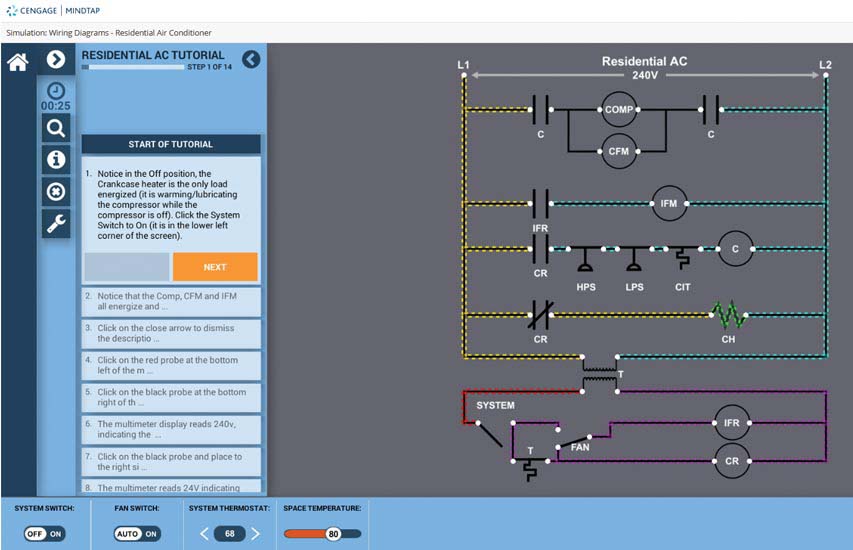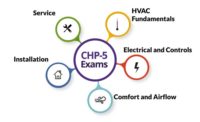School days aren’t what they used to be since the pandemic began. That holds true for HVAC training software creators, who have seen changes in target audience, user interests, and platform strategies. The good news is that for contractors and technicians, this evolution represents long-term progress, as opposed to the temporary challenges faced by so many teachers and families.
Interplay Learning CEO Doug Donovan said that his company added a significant amount of new training content in 2020, including more multi-meter content, additional entry-level HVAC material, and a new series of plumbing content.
“Cengage has focused on new supports for HVAC instructors who are teaching remotely for the first time,” said Vanessa Myers, that company’s education and technology company’s senior product manager. Myers oversees the company’s print and digital products for skilled building trades.
She has seen an unsurprising shift in asynchronous learning, where the learner can take the lesson without the real-time presence of the instructor or other students. Cengage has been working to provide more support and best practices for instructors creating that content.
Online training and hybrid learning had already been on the upswing over the last several years. As with certain trends outside of HVAC, the pandemic served to speed up the pace of embrace and growth. And as with some of those other trends, the booster-rocket effect seems likely to stick.

Click image to enlarge
WIRED FOR SUCCESS: This training walks users through wiring diagrams and proper sequences of service. Image courtesy of Cengage
“We’ve passed a tipping point with digital learning,” Myers said, based on conversations with deans and instructors. “Instructors and schools are seeing advantages to delivering theory and pre-lab work online, using time on campus for hands-on activities.
This approach has been great news for software and training companies.
“We had a remarkable increase in year-over-year sales of 300%, and customer usage is up 445% in 2020,” said Donovan, who said the year brought requests for more chiller and commercial refrigerant content.
“Companies are realizing that they need to solve their own skills gap. That means hiring for attitude and then using Interplay to help train aptitude,” he said.
Donovan singled out the company’s SkillMill™ offering that combines virtual reality and 3-D simulations. The immersive environment “uses gamification to create a highly engaging environment for the user,” he said.
While COVID-19 has put the spotlight on online training, companies in the space have not been coasting on the additional attention.
“Earlier this year, we invested in improvements to our HVAC simulation to make the onboarding and navigation simpler, on-demand, and more intuitive,” Myers said.
Part of what Cengage does is provide simulations that correlate with their various building trade textbooks.
Meanwhile, Interplay rolled out its Command Center, a customizable dashboard for assessing and managing a workforce through online skills assessments. The idea is to “capture a clear picture of the strengths and weaknesses of technicians,” Donovan said. Then, he explained, the tech or manager could select something from the course catalog to address the weakness.

Click image to enlarge
ANY MEANS NECESSARY: Simulation training fills a need because “not all students learn well from books or reading, especially in the skilled trades where learners tend to learn best via visuals or hands-on work,” said Cengage’s Vanessa Myers. Image courtesy of Cengage
Music to the ears of many in the industry, Myers said she has seen enrollment increase in the trades lately. She said that companies can use hybrid learning strategies not only to work around pandemic circumstances but to simply accommodate more students — and more types of students.
“Not all students learn well from books or reading, especially in the skilled trades where learners tend to learn best via visuals or hands-on work,” she said. Cengage’s products, such as the MindTap platform, will help to engage those students via videos, online simulations, and lab activities.
Myers does not see lab simulations as completely equivalent to their real-life counterparts, but they have their own value in preparing students for the real thing, “allowing them to make mistakes in a safe environment without extra wear on equipment, and to start visualizing the application of theory.”
Customer Point of View
On the customer side, Goodman had been working for three years on assorted training, according to Benjamin Middleton, Goodman’s national sales training manager. The company had over 70 live workshops and more than 100 on-demand training options in place as 2020 began. And then, of course, the situation changed.
“We shifted our focus immediately to live virtual trainings,” Middleton said, “and we created a series call ‘Thriving In The New Normal,’” which evolved into the HPC Accelerated Success program.
The company also commenced a relationship with Interplay. That led to its first simulation and the topic of inverter installation, offered on demand via the Omni device training platform. Goodman decided to make that material free and open to the industry.
“Even though contractors are very familiar with installing single-stage and even two-stage air conditioning systems, there’s some inherent differences when you get into a true inverter technology,” he noted.
The creation process takes some time, but Middleton described it as a successful and positive experience. First, the Goodman team established the specific skills they were targeting. Once that was done, “then it really starts to get fun, because now you build your environment and you start doing your storyboard,” he said.
Goodman and Interplay worked on ensuring that the users have the right tools in the VR environment that they would in the field, can use their hand just like they really would, and so forth.
The virtual nature lends itself to a better feedback loop, as it turns out. A typical lecture format may not generate much critical feedback.
However, Middleton said the immersive, interactive approach would lead to people coming out of a demo and saying, “Hey, this wasn’t working,” or “I couldn’t figure out how this interaction was supposed to happen.” Low-voltage wiring was one aspect that was “cumbersome in the VR environment,” and a good example of how that feedback sped up and improved the refinement process.
More Possibilities
Standalone use may be the obvious application for an HVAC training simulation, but additional angles and opportunities await. For one thing, simulations expand classroom options.
“Instead of unboxing a piece of equipment and everybody having to stand around the unit and wait to get their hands on it, you can have one volunteer in the classroom” who does the VR, Middleton explained.
Everyone can watch on the main screen as the instructor guides the volunteer through different parts of the experience. Middleton sees simulation as making the process more engaging for students versus a presenter talking through a PowerPoint deck.
Simulation can also provide a brush-up. Middleton gave the example of a tech who has an installation tomorrow. The tech might run through the simulation “real quick the night before, make sure they have all the tools they need, have all the pieces, and review all the steps again,” so everything is fresh in mind to better serve the homeowner.
Finally, Middleton said, these simulations can work well for onboarding and bringing new employees through work on basic principles as needed. In his experience, once someone does one simulation and gets comfortable with the platform, they often gravitate toward other options and topics like those in Interplay’s own large catalog. Overall, Middleton expects the various opportunities here to “be critical to the success of contractors and our dealers.”
Next Up In 2021
Goodman liked the VR maiden voyage enough that it has two more simulations in the work with Interplay Learning. One deals with combustion training, walking contractors through the impacts that venting has on combustion — dealing with fuel, gas pressures, orifice sizes, and combustion efficiency.
With the safety of the VR environment, he said, “we’re going to be able to have multiple different fuels, we’re going to be able to change oxygen mixtures,” and basically offer a range of option that often wouldn’t be practical in the real classroom.
“Then we can introduce the burners and the heat exchangers, talk about those. And they’ll be able to walk through how convection works in an 80% furnace, a 90% furnace, a modulating furnace, even low-NOx.”
The other simulation in the works addresses the principles of refrigeration and the refrigeration cycle. It will let users experience the proper ways to charge single- and two-stage systems and inverter systems.
Talking through the possibilities makes it easier to believe Interplay’s Donovan when he said, “Online training is the new normal and is here to stay.”
Cengage will also continue to push further in the realm of digital learning resources.
“Schools have invested a good amount of time and effort to move to digital and hybrid models,” Myers said.
“They are not about to let that go to waste,” she added — pandemic or not.





